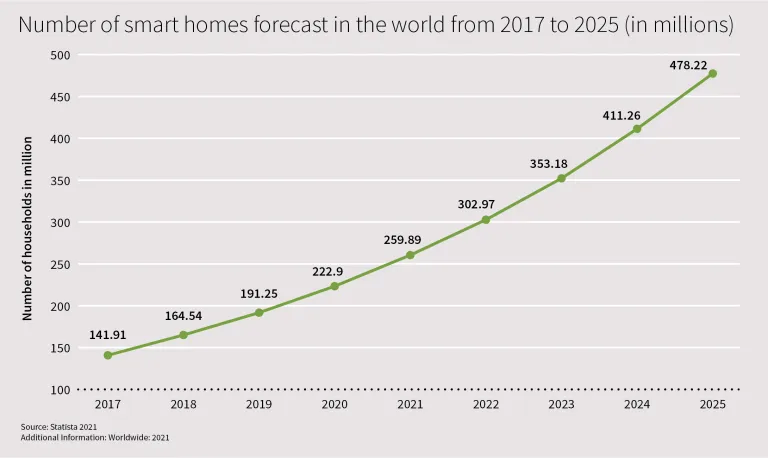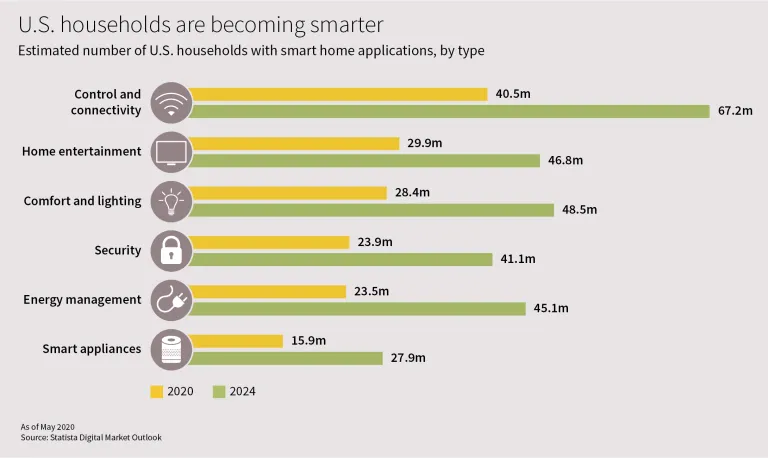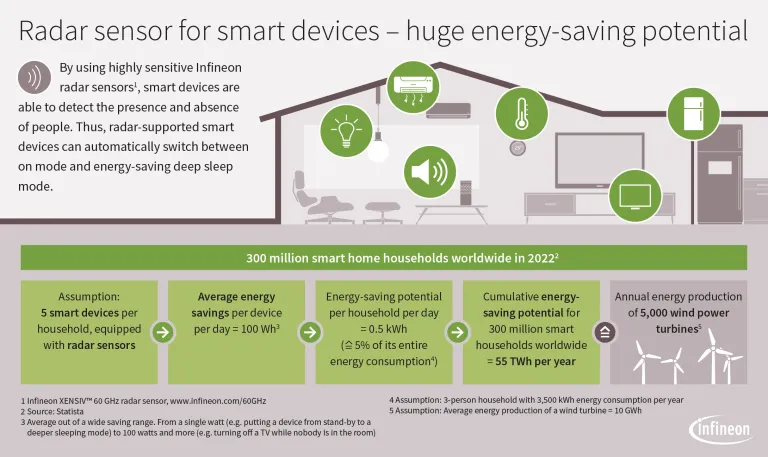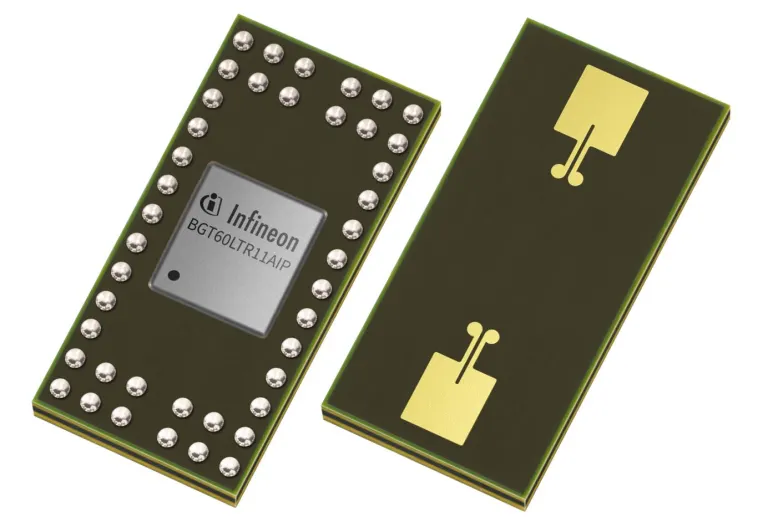The number of smart home applications and connected devices is growing, making everyday life more convenient for their users. Yet, this results in high energy consumption, as these devices often are permanently active or in standby mode in order to be ready for use at all times – even though no-one is present. By equipping smart devices with the Infineon XENSIV™ radar sensor, they become more energy-efficient and therefore smart and more sustainable.
Smart buildings and smart homes are becoming increasingly popular, and their number is expected to grow significantly in the coming years. Already today, the number of smart homes worldwide is estimated at more than 200 million, and forecasts predict that this figure will exceed 500 million within the next few years (Fig. 1).

A house can only become smart through increasingly digitalized devices with more and more ingenious functionalities. However, this comes at a high price: The need for energy is growing, despite the previous trend of steadily declining standby power consumption. Smart devices require energy even when they are “off”, since being in a standby mode is the only way for them to react instantaneously to user input (e.g. via voice control) or to provide the latest information from the smart home or web. Furthermore, there are also many occasions when it is completely unnecessary for a device to run in standby mode and thus consume energy – primarily when no one is home.
To solve this issue and to meet the requirements of both digitization and energy efficiency, Infineon leverages its semiconductor solutions. One of them is the XENSIV radar sensor, which can be applied to almost all smart home devices. Radar sensors are highly sensitive and can detect if a person is present and if the device needs to be ready – similar to a screensaver that deactivates the PC monitor after a certain time without mouse or keyboard input and reactivates it as soon as new input is noticed. Through this reliable presence and absence detection, Infineon’s 60 GHz radar sensor powers the design of truly smart, energy-saving devices.
Activity triggered by user presence versus continuous activity or standby
According to a Statista survey conducted in Germany in 2021, with 3000 respondants aged 18 to 64 years, almost three-quarters own at least one smart home device. In the U.S., the figures are similar (Fig 2), while in China, the percentage of users of smart home devices is as high as 90 percent. The devices are as diverse as their applications: they include lighting, security devices, consumer electronics such as TVs, laptops and soundbars, kitchen appliances, and air conditioners. But all these devices are increasing the demand for energy, which is an undesirable effect, especially in times of rising energy costs, when customers prefer energy-saving, sustainable, and eco-friendly devices. Moreover, the grid infrastructure is under increasing strain.

Instead of putting devices such as thermostats, smart speakers, and digital assistants into normal standby mode, one way to reduce energy consumption would be to put them into a “deep sleep mode” when no-one is present. For some devices, this can save a few watts or a fraction of that. But there are also use cases where you can save more than 100 watts if you put devices into a deep sleep mode or temporarily switch them off whenever no one is present, and they are therefore not needed – for example, the TV screen, the laptop, the sound system, and the air conditioner. By using a radar sensor, such devices will be able to sense the presence or movement of people; if these impulses remain absent, a radar-based smart device can automatically switch to sleep mode and save energy. Depending on the sensor and implementation, the radar module itself has a power consumption of only a few mW and a maximum of 0.1 W, which is significantly lower than the energy demand of the ON or standard standby mode of many electronic devices (Fig 3).

How to use radar sensors to increase energy efficiency
To save energy, the approach that devices must always be available and connected – this also includes power-hungry standby mode – needs to be reinvented. We require devices that are only active or in stand-by when really necessary, in other words, when users are present. That is what we do today in our “non-smart” homes, when we switch on the lights on entering the room or manually activate the air conditioner only when it is getting too hot inside. Still, in many devices, power-saving features like a timeout are not even implemented or else they are disabled by the user. This is also often due to the fact that those features in connection with high functionality often lead to a long boot time and lack of up-to-date information, especially after inconvenient manual reactivation, so it would significantly worsen the customer experience.
But a new smart approach could be the answer to many questions: Why does the display of a thermostat always have to be on, and why does the device itself always have to be connected to the internet to download weather data? Why is the home security system’s camera always on, recording data, pre-processing it, and transferring it to the cloud, even though no-one is moving in the area being monitored? The best way to accomplish a smarter way of activating devices is to implement motion detection enabled by a radar sensor to wake them from their deep sleep mode.
So for instance, the smart thermostat could be switched off by default while only a radar detection module is activated. As soon as the radar detects movement in the room, the thermostat is activated to update the standard data from the house and the weather data from the Internet. The display turns on when someone enters a defined area, such as within a 1 m radius of the device. So, the user does not have to touch the screen to activate it and then wait for the data to be updated and the results to be displayed. This concept of presence detection can be deployed in many other smart home devices and appliances.
Furthermore, the reverse principle of vacancy detection can also be applied, which offers an even bigger potential to save energy. In this case, devices such as televisions, loudspeakers, smart lamps, and air conditioners can be switched off if no movement is detected in the room for a certain period of time. This significantly reduces power consumption. Since vacancy detection is not about the immediate activation of a device, but the targeted deactivation when no one has been around for a while, the sensor module itself can remain deactivated and only perform a check every few seconds or minutes. As a result, such a sensor module can save a huge amount of energy for the whole system, while consuming very little itself. Especially buildings with HVAC systems can profit from this principle, since most energy is wasted for heating and cooling even though no one is present [1]. To make it worse, in many cases these devices run frequently and for long periods of time [2]. A truly smart home, however, would deactivate those systems as soon as the area has been vacated for a while. This feature is gradually becoming commonplace for lighting systems, but not yet in air conditioners and other devices such as monitors, kitchen appliances, computers, speakers, and sound systems.
Users can also benefit from vacancy detection in other applications, such as televisions. For example, Infineon’s BGT60LTR11AIP radar sensor (Fig 4.) has been implemented in Samsung’s Frame TV 2021 (Fig 5.), which switches the TV from Art Mode to Sleep Mode when nobody has been nearby for a user-specified time. This not only saves energy, but also display lifetime.


Radar sensors are the most suitable sensing option for smart home devices
Of all the available motion detection solutions, radar sensors have the highest sensitivity even for the smallest movements, some of which are even invisible to the human eye. PIR sensors cannot compete in terms of sensitivity. Also, radar does not rely on body heat like PIR sensors as it is an active sensing technology. This ensures that a person is detected even when they are barely moving or not moving at all. But arguably one of the biggest advantages is detection through non-conductive materials. While infrared, ultrasonic, camera, and other image-based sensors must not be covered or require openings in the product housing, a radar sensor can be completely hidden inside a device. As a result, you have to make no compromises in the design of the product and can avoid additional manufacturing steps and costs for a housing with corresponding adaptations. Another possibility is camera-based motion detection, for example for cameras, TVs, laptops, and other devices that already have a suitable image sensor. Image systems have very high power consumption though, they may need good ambient light conditions, and there is a need for image processing to detect motion from a video, which further requires a lot of energy. Lack of privacy is often also cited as a concern, as camera-based systems invade private spaces – so users do not fully trust them.
Furthermore, falling prices for consumer electronics are increasing cost pressure on components. Hence, 3D ToF (Time of Flight) and camera sensors are often too expensive to be implemented for presence detection. Even powerful PIR solutions, which not only affect the design of the product housing, but also require an additional Fresnel lens, amplifier, controller, etc., increase the BOM (bill of materials) cost. By comparison, Infineon’s BGT60LTR11AIP radar sensor requires only a minimum of supporting components, especially in autonomous operation, and therefore has the smallest impact on system costs. Because of their tiny size, radar sensors can also be incorporated into small and thin electronic devices.
In addition, radar sensors are robust in dusty, smoky, or humid environments where some laser-based ToF sensors or other image-based sensors might be subject to deteriorations in their detection performance.
Additional smart functionalities enabled by radar sensors
Poor handling of devices also leads to unnecessary power consumption, even though users are usually unaware of this. Hence, they waste energy unintentionally because they may be too lazy to switch off their devices or adjust the settings when they are temporarily absent. However, with the aid of radar sensors, this can be regulated automatically, so that users don’t have to think about it but have the assurance that they are not wasting energy.
Apart from being used as a presence or absence detector, radar sensors can also add other functions to smart devices, for example in air conditioning systems. In such applications, radar sensors are most efficient when combined with temperature and CO2 sensors, so the system is activated as needed – for example, when someone is in the room, when the CO2 level is too high, or when the temperature exceeds the predefined limits. Whereas other sensing technologies often provide only binary information such as presence or absence, a radar sensor can also check the number of people in the room and adjust the level accordingly at an early stage, or even check the people’s positions and distances to control the direction of the airflow.
There are many other possible use cases, for example sound systems that track the position of the listener and continuously optimize volume and sound parameters according to that tracking data. Or TVs with child care which measures the viewer’s distance and gives a warning if the child’s eyes are too close to the screen. Also in devices for the elderly or people in need of care, such as alarm systems which call for assistance in the event of a fall. Thus, with little effort, radar sensors can not only save energy and contribute to people’s comfort, but also to their personal wellbeing and safety in a smart environment.
References
[1] Martani, Claudio; et al.: ENERNET: Studying the dynamic relationship between building occupancy and energy consumption. Energy and Buildings, 2011, http://senseable.mit.edu/papers/pdf/20120401_Martani_etal_EnernetStudying_EnergyBuildings.pdf
[2] Norford, L.K; et al.: Two-to-one discrepancy between measured and predicted performance of a ‘low-energy’ office building: insights from a reconciliation based on the DOE-2 model. Energy and Buildings, 1994, https://www.sciencedirect.com/science/article/abs/pii/0378778894900051?via%3Dihub




